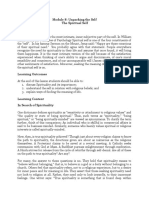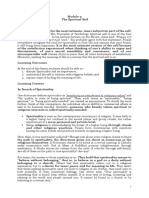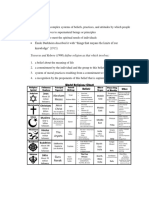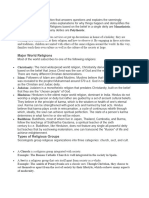0 ratings0% found this document useful (0 votes)
9 viewsMDC119
Uploaded by
linzymaryCopyright
© © All Rights Reserved
Available Formats
Download as DOCX, PDF, TXT or read online on Scribd
0 ratings0% found this document useful (0 votes)
9 viewsMDC119
Uploaded by
linzymaryCopyright
© © All Rights Reserved
Available Formats
Download as DOCX, PDF, TXT or read online on Scribd
You are on page 1/ 8
Introduction – The big questions
Why are we here? Do we have a creator? What
happens when we die? What's the meaning of life?
Humans have been asking these big questions, no
matter where or when we've lived, for thousands of
years. Somehow we still don't have definitive answers.
But people do believe in a number of different
explanations. Some believe in an all-knowing, all-
seeing god or many gods. Others believe in a spiritual
connection that we share as humans and with the
Earth. Historians, philosophers and some scholars call
these diverse ways of thinking "belief systems" or
"systems of belief".
A belief system is a network of beliefs that we each
hold about what is, or should be, right and wrong and
what is, or should be, true and false. It is more than a
collection of beliefs. What makes it different is that the
beliefs are interconnected with one another. Our
beliefs are not isolated pieces of data that we can take
and discard at will. Instead, beliefs are deeply
intertwined with other beliefs, shared cultural values,
and our identities. To discard a belief means
discarding a whole host of other beliefs, forsaking our
communities, going against those we trust and love,
and in short, challenging our identities.
Belief systems are often talked about as if they are
solely religious in nature but they do not necessarily
have to be religious or spiritual. We have religious,
political, societal, philosophical, or spiritual belief
systems, among others. It's important not to equate
"systems of belief" precisely with religious beliefs or
with religious organizations, sacred books and so on.
These diverse systems of belief and rituals have
evolved over time. They shaped—and were shaped by
—the changes in our networks of interaction, in our
communities, and in our collective understanding of
the world.
Here's an overview of some of these changes.
The earliest systems of belief imagined a spirit
world, often invisible, that existed alongside the
physical world of human communities. Some spirits
were attached to certain people, families, places, or
objects, while others controlled certain aspects of life.
These spirits weren't gods, and these belief systems
were not religions—at least not in the sense of today's
organized religions. Instead, the whole of the natural
world was a part of this spiritual world, which is often
referred to as animism. In animistic communities,
spiritual beings could be benevolent (nice) or
mischievous (naughty) or downright evil. People dealt
with the spirits according to these qualities.
Sometimes specific rituals such as dances or sacrifices
were performed to appease the spirits or ask for aid,
or to get answers. At other times a diviner (someone
who received messages from the spirit world) or a
shaman (someone who entered a trance-like state to
visit the spirit world) communicated with the spirit to
achieve a desired result. Many early belief systems
also sought to contact ancestors who had passed into
the spirit world. Everything was connected from
humans to nature to spirits—such as ghosts, fairies,
monsters, and demons. Humans asked these spirits for
protection and well-being amid the harsh realities of
Earth-bound life. In this way, belief systems provided
comfort for people in a frightening, uncertain world.
Animism served our ancestors well. It offered people
meaningful connections to the world they inhabited
and united communities through common rituals and
beliefs. It remains a common system of beliefs.
Organized systems of belief in early societies:As
communities became larger and more structured,
some belief systems changed. This probably had a lot
to do with the development of hierarchies brought on
by early farming societies. As these societies were
formed and farming created food surpluses,
specialization of labor and social hierarchies
developed. Certain members of society became
specialists such as priests and priestesses who
communicated with gods and goddesses. Additionally,
as religion became more structured, it gave rulers a
way to establish common practices and beliefs that
bound together everyone living in the state. The
increased organization of religion gave rulers more
control over their subjects, especially when the ruler
claimed to be a priest-king or divine (god-like). These
more structured beliefs systems usually had a
pantheon (collection of gods and goddesses) with a
main or supreme deity (god or goddess) at the top.
They also had creation stories about how the world
and humans originated. As exchange networks grew
and empires began conquering new territories, these
religions and their stories began to spread. Eventually,
belief systems began to change and some local
community spirits and rituals were incorporated into
the wider pantheon of deities and religious practices
among many people today.
Portable and universal systems of beliefs and
ideas:Another major change in our systems of beliefs
and ideas began in some regions around 3,000 years
ago as networks and connections among Afro-
Eurasian peoples increased. Many started to transform
their specific, local belief systems to make them more
portable. The ideas were also more universal, in that
they were open to people outside their local
community.
German philosopher Karl Jaspers was among the first
to argue that these portable and universal systems of
belief were different from those that came before in
three important ways. First, unlike previous belief
systems, these did not depend on local spirits, rituals,
or ideas tied to a specific place. As we have seen, in
those older systems, worshippers had to be close to
the sacred place—such as a river or shrine or temple
—to be able to perform the rituals or to communicate
with a spirit or god. These new systems were
"portable" in that they could be transported to
different regions. They could perform the rituals and
communicate with the spirits, gods, and goddesses just
about anywhere. A collection of scriptures or sacred
writings helped make the belief systems transportable
to new places. These texts helped ensure that new and
existing believers would be able to perform the rituals
as intended by whoever wrote them down. It was also
a way to ensure they were sincere in their beliefs and
devotion to the faith.
Second, these new systems of belief were accessible to
people beyond the local or original community of
believers. We call these systems "universal" because
they could be practiced by anyone willing to learn and
accept the required beliefs, ideas, and rituals.
Finally, along with belief and ritual these systems
inspired a change in behavior. In one way or another,
the new systems—such as Confucianism, Hinduism,
Judaism, Christianity, Islam, Daoism, and
Zoroastrianism, among others—encouraged people to
be selfless, self-disciplined, self-aware, and engage in
cooperative behavior toward other people. Many of
these portable, universal systems of belief established
compassion, charity, respect for life, and care for
children as important and necessary behaviors. Of
course, the earlier non-portable, non-universal belief
systems may have often called for these qualities as
well. But the new systems made these characteristics
part of their sacred scriptures, rituals, and guided how
people lived their daily lives.
These portable and universal systems of belief affected
and were affected by the expanding networks,
increasing populations, and more complex societies
such as empires. Over time, some of these systems of
beliefs or ideas became popular, or even became the
dominant system among most people. Historians refer
to these portable faiths as "world religions" or
universal belief systems.
Conclusion-As ideas have continued to expand across
global networks into new areas, new followers join
these world religion communities every day. But
localized belief systems still exist, including more
spiritual or animistic practices.
You might also like
- Introduction To World Religions and Belief SystemNo ratings yetIntroduction To World Religions and Belief System41 pages
- Religion - Religion and Non Religion - Year 12No ratings yetReligion - Religion and Non Religion - Year 1221 pages
- Albert Einstein: What Is Religion and Belief?No ratings yetAlbert Einstein: What Is Religion and Belief?2 pages
- Module 3 - Understanding Culture, Society and PoliticsNo ratings yetModule 3 - Understanding Culture, Society and Politics7 pages
- Religion As A Social Institution and The EffectNo ratings yetReligion As A Social Institution and The Effect19 pages
- Module 8: Unpacking The Self The Spiritual Self100% (1)Module 8: Unpacking The Self The Spiritual Self13 pages
- Introduction To World Religions and Belief SystemsNo ratings yetIntroduction To World Religions and Belief Systems7 pages
- Religion and Belief Systems: Danilo F. Maribao Paliparan Iii Senior High School Dasmarinas City, CaviteNo ratings yetReligion and Belief Systems: Danilo F. Maribao Paliparan Iii Senior High School Dasmarinas City, Cavite15 pages
- CULMINATING - Week 1-2 - Topic 1 - INTRO TO WORLDNo ratings yetCULMINATING - Week 1-2 - Topic 1 - INTRO TO WORLD70 pages
- Perspectives: An Open Invitation To Cultural Anthropology100% (1)Perspectives: An Open Invitation To Cultural Anthropology18 pages
- Understanding Religion: Belief System, Worldview, Spirituality and Religion, Theology, Philosophy Of, Elements ofNo ratings yetUnderstanding Religion: Belief System, Worldview, Spirituality and Religion, Theology, Philosophy Of, Elements of5 pages
- IWRBS - Q1 - Mod1 - Worldviews Belief Systems and ReligionNo ratings yetIWRBS - Q1 - Mod1 - Worldviews Belief Systems and Religion9 pages
- Religion and Belief Systems: Understanding Culture, Society, and Politics100% (1)Religion and Belief Systems: Understanding Culture, Society, and Politics50 pages
- RELIGION A Religion Is Any Systematic ApproachNo ratings yetRELIGION A Religion Is Any Systematic Approach14 pages
- Evolution of Religion: Atapuerca Neanderthals Hominids Grave GoodsNo ratings yetEvolution of Religion: Atapuerca Neanderthals Hominids Grave Goods18 pages
- 2023 Assesment of K&A of Colostrum FeedingNo ratings yet2023 Assesment of K&A of Colostrum Feeding9 pages
- Exploring Religion: A Comprehensive Guide to Understanding FaithFrom EverandExploring Religion: A Comprehensive Guide to Understanding FaithNo ratings yet
- Problems of Education To Indigenous PeoplesNo ratings yetProblems of Education To Indigenous Peoples11 pages
- Organization Process Structure and Culture 1No ratings yetOrganization Process Structure and Culture 115 pages
- Value and Importance of Philippine Folk DanceNo ratings yetValue and Importance of Philippine Folk Dance2 pages
- Lesson Plan Template: What Is Your Favorite Movie?No ratings yetLesson Plan Template: What Is Your Favorite Movie?4 pages
- Role of Mass-Media in Education in IndiaNo ratings yetRole of Mass-Media in Education in India21 pages
- (Ronald F. Duska) Education, Leadership and Busine (BookFi)No ratings yet(Ronald F. Duska) Education, Leadership and Busine (BookFi)342 pages
- Unit 5: Oral Communication. Elements and Rules. Routines and Formulaic Language. Oral Communication StrategiesNo ratings yetUnit 5: Oral Communication. Elements and Rules. Routines and Formulaic Language. Oral Communication Strategies13 pages
- Economic Action and Social Structure: The ProblemNo ratings yetEconomic Action and Social Structure: The Problem7 pages
- The Etymology of İstanbul: Making Optimal Use of The EvidenceNo ratings yetThe Etymology of İstanbul: Making Optimal Use of The Evidence25 pages
- Nicolás Maquiavelo Is One of The Most Renowned Political Thinkers of The Renaissance EraNo ratings yetNicolás Maquiavelo Is One of The Most Renowned Political Thinkers of The Renaissance Era1 page
- Module 3 - Understanding Culture, Society and PoliticsModule 3 - Understanding Culture, Society and Politics
- Introduction To World Religions and Belief SystemsIntroduction To World Religions and Belief Systems
- Religion and Belief Systems: Danilo F. Maribao Paliparan Iii Senior High School Dasmarinas City, CaviteReligion and Belief Systems: Danilo F. Maribao Paliparan Iii Senior High School Dasmarinas City, Cavite
- Perspectives: An Open Invitation To Cultural AnthropologyPerspectives: An Open Invitation To Cultural Anthropology
- Understanding Religion: Belief System, Worldview, Spirituality and Religion, Theology, Philosophy Of, Elements ofUnderstanding Religion: Belief System, Worldview, Spirituality and Religion, Theology, Philosophy Of, Elements of
- IWRBS - Q1 - Mod1 - Worldviews Belief Systems and ReligionIWRBS - Q1 - Mod1 - Worldviews Belief Systems and Religion
- Religion and Belief Systems: Understanding Culture, Society, and PoliticsReligion and Belief Systems: Understanding Culture, Society, and Politics
- Evolution of Religion: Atapuerca Neanderthals Hominids Grave GoodsEvolution of Religion: Atapuerca Neanderthals Hominids Grave Goods
- Exploring Religion: A Comprehensive Guide to Understanding FaithFrom EverandExploring Religion: A Comprehensive Guide to Understanding Faith
- Lesson Plan Template: What Is Your Favorite Movie?Lesson Plan Template: What Is Your Favorite Movie?
- (Ronald F. Duska) Education, Leadership and Busine (BookFi)(Ronald F. Duska) Education, Leadership and Busine (BookFi)
- Unit 5: Oral Communication. Elements and Rules. Routines and Formulaic Language. Oral Communication StrategiesUnit 5: Oral Communication. Elements and Rules. Routines and Formulaic Language. Oral Communication Strategies
- The Etymology of İstanbul: Making Optimal Use of The EvidenceThe Etymology of İstanbul: Making Optimal Use of The Evidence
- Nicolás Maquiavelo Is One of The Most Renowned Political Thinkers of The Renaissance EraNicolás Maquiavelo Is One of The Most Renowned Political Thinkers of The Renaissance Era

























































































